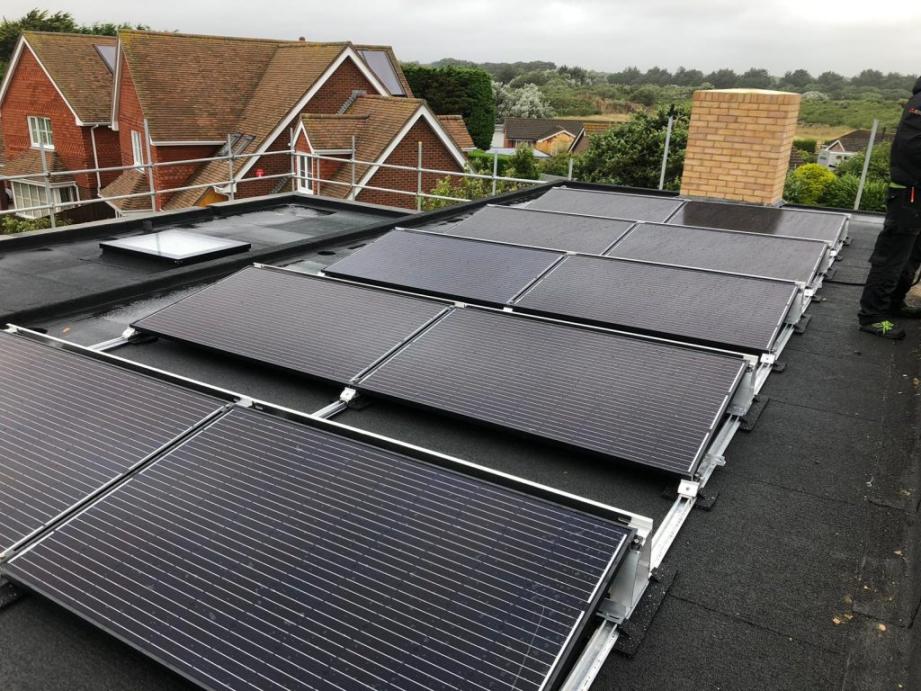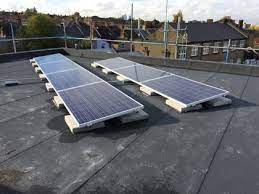Solar panels have become an increasingly popular choice for individuals looking to harness clean, renewable energy to power their homes or businesses. However, when it comes to installation, many people are left wondering if solar panels can be effectively installed on a flat roof.
The good news is that solar panels can be successfully fitted on a flat roof, offering a great opportunity to reap the benefits of green energy. There are, however, some challenges to be aware of and considerations to make when opting for this kind of setup, such as planning permission and costs. In this article, we will explore the key factors to take into account when installing solar panels on a flat roof, aiming to provide an informative and concise guide for those considering such an investment.

Installing solar panels on flat roofs is indeed possible and can be an effective way to harness solar energy. However, there are some challenges that need to be considered to ensure successful installation and performance.
The primary concern when installing solar panels on a flat roof is their positioning. Typically, mounting the panels at a pitch that captures the maximum sunlight is necessary for greater efficiency. This angle varies depending on your location, but an average is usually around 30 to 45 degrees.
Moreover, it's important to avoid shading caused by nearby structures or objects, as this can significantly reduce the performance of the solar panels. If properly designed, a flat roof solar installation can be just as effective, if not more so, than traditional pitched roof installations.
There are several mounting systems available for installing solar panels on flat roofs. One popular option is the ballasted system, which relies on the weight of the panels and the mounting system itself to secure the installation, eliminating the need for extensive drilling and penetrations.
In conclusion, while there are challenges with installing solar panels on a flat roof, they can be successfully mounted with the right considerations and installation methods. When properly installed and designed, a flat roof solar installation can be a highly effective and efficient way to utilise solar energy.
There are several methods for mounting solar panels on flat roofs, each with its own advantages and challenges. It is essential to choose the right method based on the roof's structure and materials, as well as the specific requirements of the solar panel system.
One popular method for mounting solar panels on flat roofs is using rails. Rails provide a secure foundation for the panels and can be easily adjusted to achieve the optimum tilt angle for maximum energy production. These railing-based systems offer ease of installation, as the solar panels simply clip onto the rails.
Another option for flat roof mounting is ballasted systems, which rely on the weight of the panels and additional ballast materials, such as concrete blocks, to hold the solar panels in place. Ballasted systems minimises roof penetrations and may be suitable for buildings with weight-bearing limitations. This method can be customised to fit various building requirements, including mechanically attached or hybrid systems.
When multiple panels are installed, a tilt mount system can be utilised. This method allows the panels to be oriented in an optimal direction, and the angle can be adjusted to match the building's latitude. This ensures maximum sun exposure and energy production throughout the year.

When planning to install solar panels on a flat roof, it is crucial to consider several factors to ensure optimum efficiency and a secure setup. The first consideration is the angle or tilt of the solar panel system. Unlike pitched roofs, flat roofs require the panels to be mounted at an angle to optimise sunlight exposure. Solar panel mounts and racking systems are specifically designed for this purpose and can be adjusted to achieve the desired angle.
Another important consideration is the spacing between the solar panels. Flat roofs often have limited space, and shadows cast by neighbouring panels can reduce the overall system efficiency. To minimise shading, it is necessary to calculate the appropriate distance between panels and account for the sun's position throughout the year.
Wind resistance is another critical factor for solar panel installations on flat roofs. The location and orientation of the panels may make them susceptible to high winds or uplift forces. To ensure that the system remains safe and secure, it is essential to select an appropriate mounting system and adhere to local building regulations regarding wind load.
Lastly, potential roof penetrations must be addressed during the installation process. Most mounting systems for flat roofs do not require roof penetrations, utilising ballasted or non-penetrating mounts instead. However, if penetrations are required, it is essential to ensure proper sealing and waterproofing to prevent roof damage and leaks.
There are several advantages and disadvantages of installing solar panels on flat roofs. This section will provide a brief overview of them.
Advantages:
Disadvantages:
Regular maintenance and cleaning of solar panels on flat roofs is essential to ensure optimal performance and longevity. Flat-roof solar panels tend to accumulate more dirt, grime, and debris than those on pitched roofs, which can reduce their efficiency over time.
General maintenance of flat-roof solar panels includes regular inspections to check for any damage, such as cracked panels or loose connections. In addition, it is essential to keep the surrounding area free from shadows caused by nearby structures or vegetation, as these can interfere with the panels' performance.
When it comes to cleaning, it is important to avoid using harsh chemicals or abrasive tools that may damage the panels. Instead, you can use a soft brush or a sponge with a mild, non-abrasive soap solution to gently clean the surface of the panels. Rinsing with clean water and allowing the panels to air dry is the best method to avoid leaving any residue behind.
In some cases, professional cleaning may be required, especially if your panels are in an area with high pollution or bird droppings. If you are unsure whether your panels need professional cleaning, it is advisable to consult with a solar panel maintenance expert who can assess the state of your solar panels and provide the appropriate cleaning services.
Installing solar panels on a flat roof can be a worthwhile investment, with the cost and return on investment (ROI) largely influenced by location, climate, and any available local or national financial incentives. As a guide, solar PV systems typically cost between £1,400 and £1,750 per kWp of installed capacity, depending on system size and complexity.
Solar panels for residential use often have an average cost of around £5,500. However, the overall expense varies depending on the size, quality, and brand of the solar panels. It is essential to consider these factors alongside the installation and maintenance costs when evaluating the potential return on investment.
On average, homeowners can expect to pay between £15,000 to £25,000 to purchase and install a solar system for their flat roof. These costs can be offset in part by government incentives, such as the Smart Export Guarantee (SEG), which allows homeowners with solar panels to receive payments for any surplus electricity they export to the national grid. Additionally, energy savings will contribute to recouping the initial investment over time.
It is crucial to remember that solar panel ROI is a long-term investment, often considered akin to buying a house. Typical payback periods can range from 7 to 20 years, depending on multiple factors such as initial costs, energy production, and energy consumption rates. To fully determine if solar panels are the right choice for your flat roof, it is advised to seek professional guidance and carry out a thorough cost-benefit analysis before proceeding with installation.
In summary, installing solar panels on a flat roof is not only feasible but can be advantageous in certain situations. Flat roofs provide a versatile space for solar panel installation, making it easier for the panels to be adjusted and positioned for optimal sunlight exposure. Furthermore, the installation process on a flat roof can sometimes be less expensive compared to a pitched roof due to reduced labour costs.
However, it is essential to consider the slight energy loss associated with laying panels flat, as they are less efficient when not inclined towards the sunlight. To address this issue, using panel mounting systems that position the panels at an appropriate angle can help in maximising energy generation.
Lastly, it's crucial to check the manufacturer's warranty on solar panels before installation, as laying them flat in some cases can lead to voiding the warranty. By carefully considering the factors involved in flat roof solar panel installations and collaborating with experienced solar panel installers, homeowners and businesses can successfully harness solar energy and contribute to a greener future.